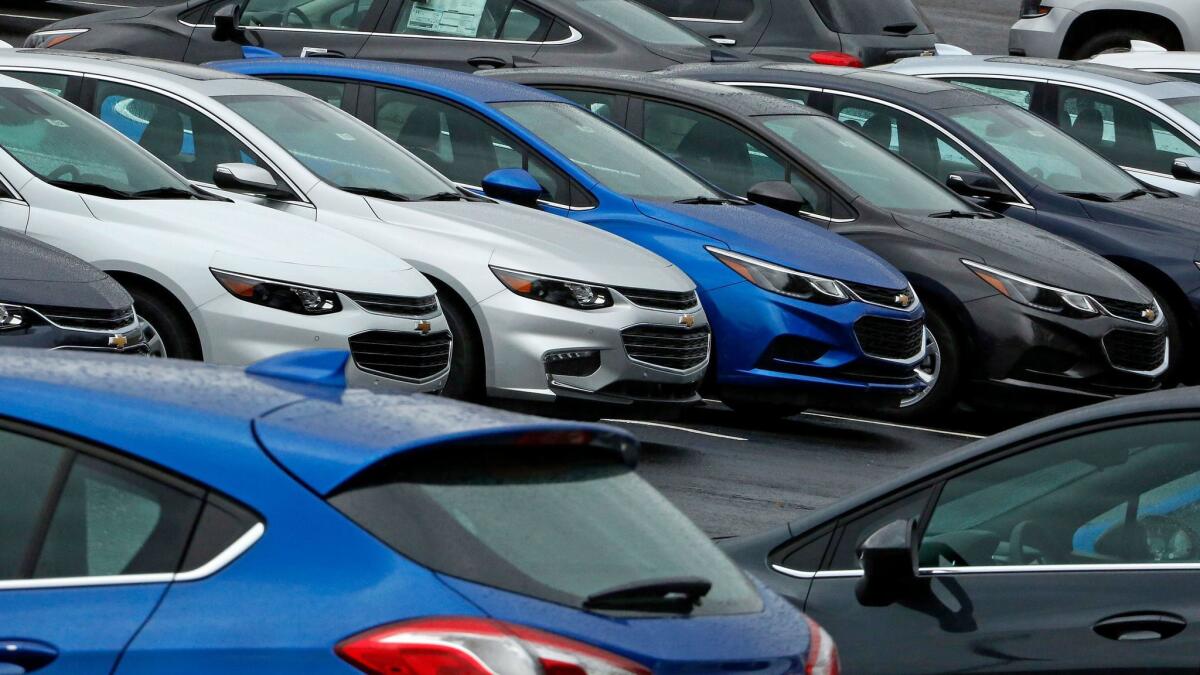Auto sales fall again, but buyers flock to SUVs and trucks

Unemployment is down, consumer confidence is up, and gas prices and interest rates are still low.
Even so, U.S. auto sales fell 3% last month.
It was the sixth straight monthly decline as sales dropped off last yearâs record pace. For the first six months, car and truck sales fell 2.1%, the first such decrease since the financial crisis in 2009.
But auto executives and industry analysts say itâs no cause for panic. Sales are still strong and arenât expected to plunge anytime soon. Plus, buyers are still loading out trucks and SUVs with high-priced options, and thatâs likely to boost earnings, at least in Detroit.
Sales are falling largely because people who delayed car and truck purchases in the years since the Great Recession have bought new ones, said Jessica Caldwell, executive director of analysis for Edmunds.com.
âWeâre kind of at the point where we donât have a boost from that,â she said.
Also, auto companies are cutting lease deals as used-car values fall, curtailing another incentive to buy. And people with lower credit scores are feeling the pinch from lenders tightening standards a bit, sending many into the used car market, Caldwell said.
In June, Ford, General Motors, Fiat Chrysler and Hyundai all reported sales drops. Fiat Chrysler sales were down 7.4%, while Ford said its sales declined 5%. GM was off 4.8% and Korean automaker Hyundai posted a hefty 19.3% decrease.
Nissan, Toyota and Honda each reported small increases Monday, but they werenât large enough to offset declines in Detroit. Volkswagen brand sales rose 15% over depressed numbers from June 2016.
Autotrader senior analyst Michelle Krebs says the small first-half dip is not an indication of broader economic troubles. She doesnât expect a big recovery in the second half of the year, but also doesnât see a huge decline, predicting full-year sales from 16.8 million to 17.3 million. Thatâs still below last yearâs record of 17.55 million.
âWe think the second half could be a little bit stronger than the first half was,â said Krebs, who expects 2016 still to be the fifth-best year on record. âWe donât see any imbalances that suggest anything is going to collapse.â
U.S. buyers continued a trend theyâve been following for years, purchasing SUVs and trucks and shunning cars.
Car sales fell 13% in June while trucks and SUVs rose 4%, according to Autodata Corp. Trucks and SUVs accounted for 63% of sales last month. Just five years ago they were less than half.
Sales of Toyotaâs Camry, normally the top-selling non-pickup truck in the U.S., fell nearly 10%. But Fordâs F-Series pickup, the top-selling vehicle in America, rose nearly 10%.
Slowing car sales are good for consumers who are looking to buy a car, Caldwell said. Dealer inventories are growing before production cuts take effect and discounts are rising, so now is the time to buy.
Even with the sales decline, auto prices remain high, according to J.D. Power and LMC Automotive. The average vehicle sold for $31,720 in June, a record for the month, surpassing the old record of $31,073 set last year.
Some automakers are having to raise discounts and sell more vehicles to rental car companies to keep their sales numbers up. The average incentive spend per vehicle in June was $3,661 in June, also a record for the month. Even spending on trucks and SUVs is up about $350 from last year, J.D. Power and LMC estimated.
UPDATES:
5:50 p.m.: This article was updated with final sales results for June.
10:05 a.m.: This article was updated to add perspective from Mark LaNeve, Fordâs vice president of sales, and Jeff Conrad, general manager of Hondaâs U.S. division.
This article was originally published at 7:55 a.m.
More to Read
Inside the business of entertainment
The Wide Shot brings you news, analysis and insights on everything from streaming wars to production â and what it all means for the future.
You may occasionally receive promotional content from the Los Angeles Times.










